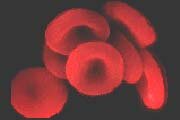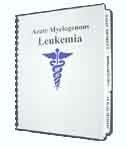 |
||
| HOME | ||
 |
||
| Acute Myelogenous Leukemia (AML) |
||
 |
||
| Other Leukemia Types (ALL / CLL / CML / HCL) |
||
 |
||
| Myelodysplastic Syndrome | ||
 |
||
| Symptoms and Diagnosis | ||
 |
||
| Leukemia Treatment Options | ||
 |
||
| " Chemotherapy | ||
 |
||
| " Blood Stem Cell Transplants | ||
 |
||
| " Radiation and Surgery | ||
 |
||
| " Chemo Side Effects | ||
 |
||
| " Clinical Trials Info | ||
 |
||
| " Coping with Leukemia | ||
 |
||
| " What to Ask Your Doctor | ||
 |
||
| Financial Assistance | ||
 |
||
| At Risk Jobs/Exposure | ||
 |
||
| Leukemia Resources | ||
 |
||
| Survivor's Story | ||
 |
||
| Leukemia News | ||
 |
||
|
Search for information:
|
||

|
Leukemia Cancer News - Return to Menu Blair Manning has a blood sample drawn at Henry Ford Hospital, where she receives care for leukemia. Volunteers say that lack of information and distrust of the medical community keep blacks from joining the bone marrow registry. Lack of bone marrow donors hurts minorities Failure to educate public, distrust of medical profession linked to shortage. By Maureen Feighan / The Detroit News OAK PARK - May 9, 2005 - For Blair Manning, it started with mysterious bruises, gums that bled every time she brushed her teeth and fatigue so bad she just wanted to sleep. The 24-year-old Baker College student thought she was dealing with a second bout of bronchitis when she went to the emergency room in February for breathlessness. But a blood screen would soon change her life forever. She had leukemia. "I had never been hospitalized before, never had any medical problems and all of sudden you're diagnosed with this deadly disease," said Manning, who has endured two rounds of chemotherapy with five more to go. "I can't even describe the shock I was in." For Manning and thousands of minorities like her, the journey to beat leukemia isn't just about chemotherapy, radiation and prayers for remission. It's about the elusive search to find a bone marrow or blood cell donor. A shortage of minority marrow donors continues to be a major problem for African-Americans, Asians, Hispanics and American Indians suffering from diseases of the blood and immune system such as leukemia and lymphoma. Since tissue types are inherited, patients in need of a bone marrow transplant are most likely to match with someone from the same ethnic group. Of the 5.5 million potential donors in the National Marrow Donor Program's registry, only 430,000 are African-American, 400,000 Hispanic and 360,000 Asian. And while the National Marrow Donor Program is trying to boost its potential donor ranks with a pilot program now in place in Detroit, Cleveland and Atlanta to raise awareness and education among African-Americans, the shortage still exists. The shortage is attributable to fewer potential donors, increased difficulty finding matches, lack of awareness about the need, difficulty retaining potential donors and, in some cases, distrust of the medical community. The shortage is most acute among African-Americans. Once cancerous cells have been eliminated through radiation or chemotherapy, a transplant provides new marrow or blood cells from which cancer-free cells can grow. "I don't think people realize how important it is (to be a potential donor) until they're in that situation," said Jillian Wren-Phillips, whose 23-month-old son William "Little Will" Phillips III is battling acute myelogenous leukemia. "It gets pushed to the back burner. They don't understand how big a need there is." Hetal Vyas of West Bloomfield is doing everything he can to boost the number of Asian Indians on the national registry after his son, Rajan, 7, was diagnosed in February with acute lymphoblastic leukemia. In a matter of six weeks, Vyas' friends and family have already held more than 50 drives nationwide and added 2,800 people to the registry's ranks, most of Asian Indian descent. And while a perfect match for Rajan hasn't been found yet - he needs a transplant very soon - Hetal Vyas said at least they've found donors other families may be able to use. "Every individual should be in the registry," said Vyas, 40. "It doesn't matter if you're Asian Indian, African-American, Caucasian. If you match, you can save someone's life." Needle-in-a-haystack search According to the National Marrow Donor Program, 3,000 people at any given time are actively searching the registry for a potential marrow or blood cell donor. Only 30 percent of patients find a match in their family. Finding the right match is a detailed, involved process that essentially comes down to genetics. Each person inherits six tissue types - markers on white blood cells - from their parents, three from each. A successful donation requires the donor to have at least five of the same tissue types as the recipient. Caucasians tend to have more of the same gene combinations in their tissue types, making it easier to find donors, said Dr. John Levine, clinical director of the Pediatric Blood and Marrow Stem Cell Transplantation Program at the University of Michigan's Mott Children's Hospital. That isn't the case with many minorities. "If something is less common, it becomes harder to find," Levine said. "A smaller pool of people and tissue types that are less common - and with lower retention (on the registry that tracks donors) - it's a triple whammy." The national marrow program is making progress in finding more matches for patients of color. As of July 1995, the program had only facilitated 89 transplants for African-American patients from unrelated donors since the registry's inception in 1987. As of March, 911 transplants have occurred. Barb Rozier's daughter, Monica, counts herself among the lucky. In 1994, Monica was diagnosed with acute lymphoblastic leukemia. After four years of chemotherapy and no marrow donor in sight, doctors told Barb to brace herself for Monica's death. But fate would soon connect them with a man playing basketball in a park in Florida where a marrow drive was happening nearby. "At the 11th hour, we got a call that we had found a donor," Rozier said. "She's doing wonderful now. She's 16 and a junior at Southfield Lathrup High School. But there's no question Monica wouldn't be here today if we hadn't found a donor." Obstacles impede process Still, Rozier, who now works for the National Marrow Donor Program in Detroit to boost education in the African-American community, acknowledges that awareness and sometimes distrust of the medical community prevents some people of color from joining the registry. Retention on the registry can also be a problem in some communities, said Helen Ng, a spokeswoman for the National Marrow Donor Program. Once someone gives blood to join the registry, they stay on the list until they turn 61 as long as they remain healthy. If a donor moves, the information on the registry needs to be updated. Ng said the registry used to contact each potential donor once a year but now targets certain groups more often and also uses e-mail. "Because donating and becoming a potential donor is not as simple as just a drop of blood - it's more involved, involves more commitment and you're on the register until the age of 61 - it's important for people to get all the information and be as informed as they can be," Ng said. "Patients are counting on you." As medicine advances, leukemia and lymphoma patients do have more treatment options beyond traditional bone marrow transplants from unrelated donors, doctors say. Levine said up to 30 percent of the marrow transplants U-M now performs are actually from umbilical cord blood. Umbilical cord blood contains life-saving stem cells that can make new blood and marrow. And unlike the criteria for marrow transplants from outside donors, four tissue matches out of six have to be made for a transplant to occur. "That opens a lot of doors for people of color," Ng said. Doctors have found a possible umbilical cord match for Rajan Vyas of West Bloomfield. His father, Hetal, said he feels fortunate that something is available but is keeping his fingers crossed an even better match will surface. A closer match means less chance of rejection. A condition called Graft Versus Host Disease is a leading cause of death in bone marrow transplants because the immune cells of the transplant can attack the patient, Levine said. U-M is conducting clinical trials using an arthritis drug called Enbrel to cut the onset of the disease in half at the hospital. "We would consider this a major advance," Levine said. Manning, meanwhile, is trying to focus her energy on beating her disease and making it to 25. "Nobody can tell me if you set your mind to something that it can't be done," she said. "All my energies are focused on getting better."
|
|
|


